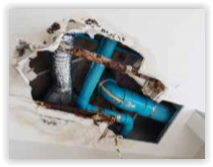A Nasty Situation
HOW BUILDING OWNERS AVOID MOLD PROBLEMS
 Indoor air quality and mold problems go hand in hand. There are many times when mold proves to be the source of a tenant’s IAQ complaints. This is because molds are found everywhere and can thrive with ease.
Indoor air quality and mold problems go hand in hand. There are many times when mold proves to be the source of a tenant’s IAQ complaints. This is because molds are found everywhere and can thrive with ease.
Mold only needs three things to grow: A surface conducive to growth (e.g., gypsum wallboard, acoustical tile, or wood products), oxygen, and moisture. Remove any one of these and mold won’t be a problem in your building. But, considering most buildings are full of wallboard, acoustical tile, and wood products, property owners and building managers need to focus their energy on preventing and addressing moisture.
Most of the time, preventing moisture is as simple as preventing leaks. But if avoiding leaks were so easy, mold would be a much rarer problem in commercial buildings than it is. Water leaks happen, and when they do, the saturated materials need to be dried right away. If they cannot be dried thoroughly, the material needs to be removed or replaced. However, drying or removing saturated material won’t be effective if you don’t first determine the source of the leak and repair it. All of this can require a bit of work, but the truth is, it’s a lot easier (and cheaper) to dry water and repair leaks than it is to fix a mold problem.
What about when leaks aren’t found in time? What if a plumbing leak is hidden within a wall or beneath wallpaper, or moisture is coming from an external source and mold sneaks in? How should building owners address a mold problem once one is discovered in their building?
The laws around mold remediation vary from state to state. In some places, if mold is in a section greater than 10 square feet, building owners are legally obligated to hire a mold assessment consultant. However, in Texas, building owners can address mold problems themselves as long as the area affected is less than 25 square feet of contiguous mold. But if the mold problem grows to be greater than that, a mold assessment consultant must be hired and the building owner is required to use a state-licensed remediator for removal.
After calling a consultant or remediator out to help with a mold problem, remember one simple tip: Do as they say! In order to deal properly with a mold problem, building owners need to follow the remediator or consultant’s instructions to the letter, even if those instructions “don’t make sense” or they “don’t sound that serious.” Tenants can be notoriously hysterical about mold, and if a person gets sick in your building after you fail to follow the mold remediator’s instructions, you can be held liable.
If a mold consultant instructed you to dry both sides of a wall in two separate rooms, set those fans up right away. If a mold problem is discovered to be bigger than 25 square feet, get on the phone with a state-licensed remediator. And above all else, find those leaks early!
